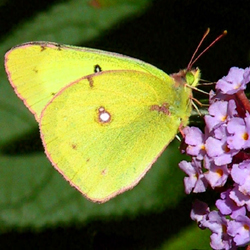Butterfly Atlas
Find a Butterfly
Clouded Sulphur
Colias philodice
Named
Godart, 1819

Taxonomy & Nomenclature
Also known as Common Sulphur.
Identification
Wingspan: 1 3/8-2". Medium sized sulphur. Clear lemon yellow above, with solid black borders in the male, yellow spotted black borders in the female. "Alba" form of the female has white replacing yellow and is generally indistinguishable from "alba" form of Orange Sulphur. Hybrids with Orange Sulphur exhibit various combinations of yellow and orange upperwing coloration. Very similar to Pink edged Sulphur (see Identification under that species).
Distribution
Continent wide, from arctic Alaska to Newfoundland, southward to southern Mexico and Guatemala. Absent from southern California coastal regions and lower Florida; scarce along Gulf Coast. In New England, it is widespread and common.
Status in Massachusetts
A century ago, the Clouded Sulphur was, in the words of Samuel Scudder "everywhere the commonest species to be found..." Today, it remains one of the most abundant species and is found throughout the state at all elevations. Maximum: 300, Merrimac (Essex Co.) 27 August 1988.

Flight Period in Massachusetts
Three overlapping broods, with individuals typically flying from early May to mid October. Peak flight periods (from Scudder, 1889) are late May, second half of July, and late August. Extreme dates: 13 April 1989, West Dennis (Barnstable Co.), B. Cassie and 21 November 1990, Middleboro (Plymouth Co.), K. S. Anderson.
Larval Food Plants
White Clover (Trifolium repens), Alfalfa (Medicago sativa), sweet clovers (Melilotus spp.) and vetches (Viceia, spp.) are favored food plants in the East; note that all of these are introduced Eurasian species. Other legumes (Scott, 1986, lists fifteen genera) are eaten as well.
Adult Food sources
Atlas volunteers found this species taking nectar from 43 different species of plants. The 300 at Merrimac on 27 August 1988 (See above) were nectaring at Purple Loosestrife, Joe Pye Weed, Boneset and goldenrods.

Habitat
Nearly ubiquitous in open areas, such as meadows, pastures, and gardens.
Life Cycle
EGG: Yellow when fresh, then changing to crimson; spindle shaped. OVIPOSITION: Eggs laid singly on top side of host plant leaf; hatch in about five days. LARVA: Green, with darker stripe down the back and whitish lateral stripes; attains full size in three weeks. CHRYSALIS: Green, and pointed at both ends. PUPATION: averages ten days in the non-wintering generations. OVERWINTERING STAGE: Chrysalis.
From mid spring to fall, Clouded Sulphurs are the prototypical meadow butterfly, cruising low over the grasstops with a vigorous, searching flight. During courtship, females respond to the male‘s pheromone, which is released when the male buffets her with his wings, causing the female "to extend the abdomen out from the hindwings such that the male can join." (Scott, 1986).
Males of this and other sulphur species congregate at puddles and other moist ground possibly to take nutrients from the wet soil. These so called "mud puddle clubs" or "puddling" groups may reach impressive proportions: "Thousands may sometimes congregate in a few square rods." (Scudder, 1889).
Account Author
Chris Leahy



